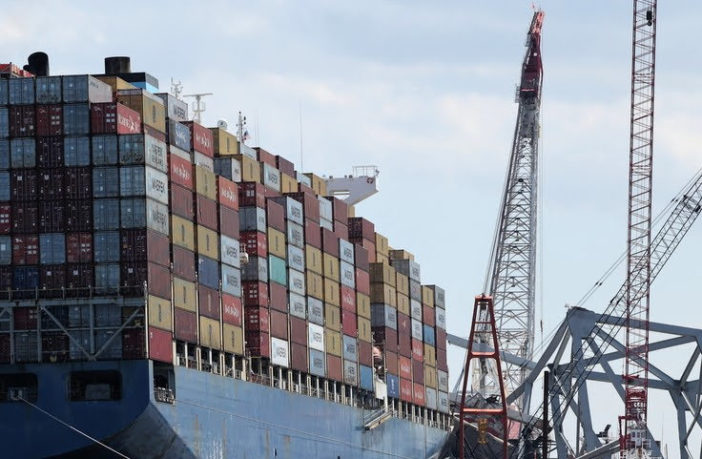By Megan Sayles
AFRO Business Writer
msayles@afro.com
Governor Wes Moore shared progress updates on ongoing efforts to clear the Fort McHenry shipping channel and return the Port of Baltimore to full operational capacity at the Maryland Transportation Police Authority Headquarters on April 10.
Since the collapse of the Francis Scott Key Bridge, most vessel traffic has been suspended. The 984-foot Dali cargo ship, which struck the bridge, remains in the Patapsco River amongst the steel remains of the bridge.
Two temporary passageways have been opened since the catastrophe, allowing smaller vessel traffic into the port. According to Moore, the respective 11- and 14-foot channels have experienced 58 commercial movements as of April 9— merely a fraction of the usual traffic that passes through the 50-foot channel.
Baltimore’s Key Bridge clean-up is moving along slowly, as salvage crews work to restore traffic to the Port of Baltimore. AFRO Photo/James Field
“Let’s be clear, even with those 58 movements, we’re still only talking about 15 percent of what vessel traffic looked like before the collapse,” said Moore. “Even when you factor in vessels that are going to Tradepoint Atlantic, the economic activity is likely even lower than that 15 percent.”
Tradepoint Atlantic, located in Sparrows Point, has ramped up its capacity to collect cargo and debris as docks inside of the wreckage wait for the Fort McHenry channel to fully reopen. Steel wreckage from the bridge is being taken to the logistics center, which has a 35-foot channel.
Authorities are on track to open a 35-foot-deep, 280-foot wide channel by the end of the April, according to Moore. The U.S. Army Corps of Engineers are aiming to reopen the permanent channel by the end of May.
 By the end of April, authorities plan to open a 35-foot temporary channel, before aiming to open the permanent 50-foot channel at the end of May. Photo: AFRO Photo/James Fields
By the end of April, authorities plan to open a 35-foot temporary channel, before aiming to open the permanent 50-foot channel at the end of May. Photo: AFRO Photo/James Fields
As debris is cleared from the waterway, authorities are also working to remove containers from the Dali. As of April 9, 34 containers have been extracted. The present goal is to remove 178 in total before preparing to refloat the ship.
“I want to be clear on that as well. That work is complicated, and that work is dangerous because just one empty container that’s sitting on the vessel can have a weight of over 1.5 tons,” said Moore.
The governor called on the federal government to display bipartisan support and cooperation in the wake of the disaster. He highlighted their response after the 2007 collapse of the I-35W Mississippi River Bridge in Minneapolis, Mn. The tragedy resulted in the deaths of 13 people, with more than 100 others injured.
“Members of Congress, of both parties, must come together again and act with the same level of urgency and partnership that they did in 2007,” said Moore. “This administration is ready and willing to work with anybody and everybody.
At the time of the incident, Democrats controlled both the House and Senate under Republican President George W. Bush. Moore said they worked together to deploy $250 million in emergency funds the day after the bridge collapsed. Two days after the Key Bridge collapsed, the U.S. Department of Transportation’s Federal Highway Administration announced $60 million in quick release emergency relief funds for the bridge’s reconstruction.
Moore stressed the need for both political parties to come together again and display the same level of urgency and partnership in response to the Key Bridge collapse.
“To members of the U.S. House and members of the U.S. Senate, my message is simple: Come to Maryland. Work with our congressional delegation. Sit down with me and my team. Get up close to the wreckage. See it for yourself. See what we’ve been seeing for two weeks. See what it looks like when a steel bridge falls on top of a shipping vessel that is the size of the Eiffel Tower,” Moore said.
The loss of the bridge and interruption to the Baltimore port has impacted thousands of dock workers and shipping and trucking companies. Last week, the Biden-Harris administration announced an initial $3.5 million in dislocated worker grants to the state of Maryland.
On April 9, Moore signed the Maryland Protecting Opportunities and Regional Trade (PORT) Act into law. The legislation will provide financial relief to affected workers and businesses. It also establishes a scholarship program for the children of roadside workers who are killed on the job.
Mayor Brandon M. Scott released an Action Plan on April 10 to delineate Baltimore’s continual efforts to support port workers and businesses. The outline includes funds for rent and electricity and water bills.
“I’ve directed the entire city government to provide workers impacted by the bridge collapse access to energy assistance through the Maryland Energy Assistance Program and water bill support through the city’s Water4All assistance program,” said Scott. “Additionally, we’ll be providing $500,000 into our ongoing rental assistance program, specifically for eligible port workers.”
Scott also said the city is considering deploying an additional $1 million in wage subsidies for impacted workers.
“These two buckets of support will be going directly to city residents impacted by this tragedy to help address one of the biggest looming problems: bills coming due when there’s not much work to be had,” said Scott.
Megan Sayles is a Report for America corps member.



